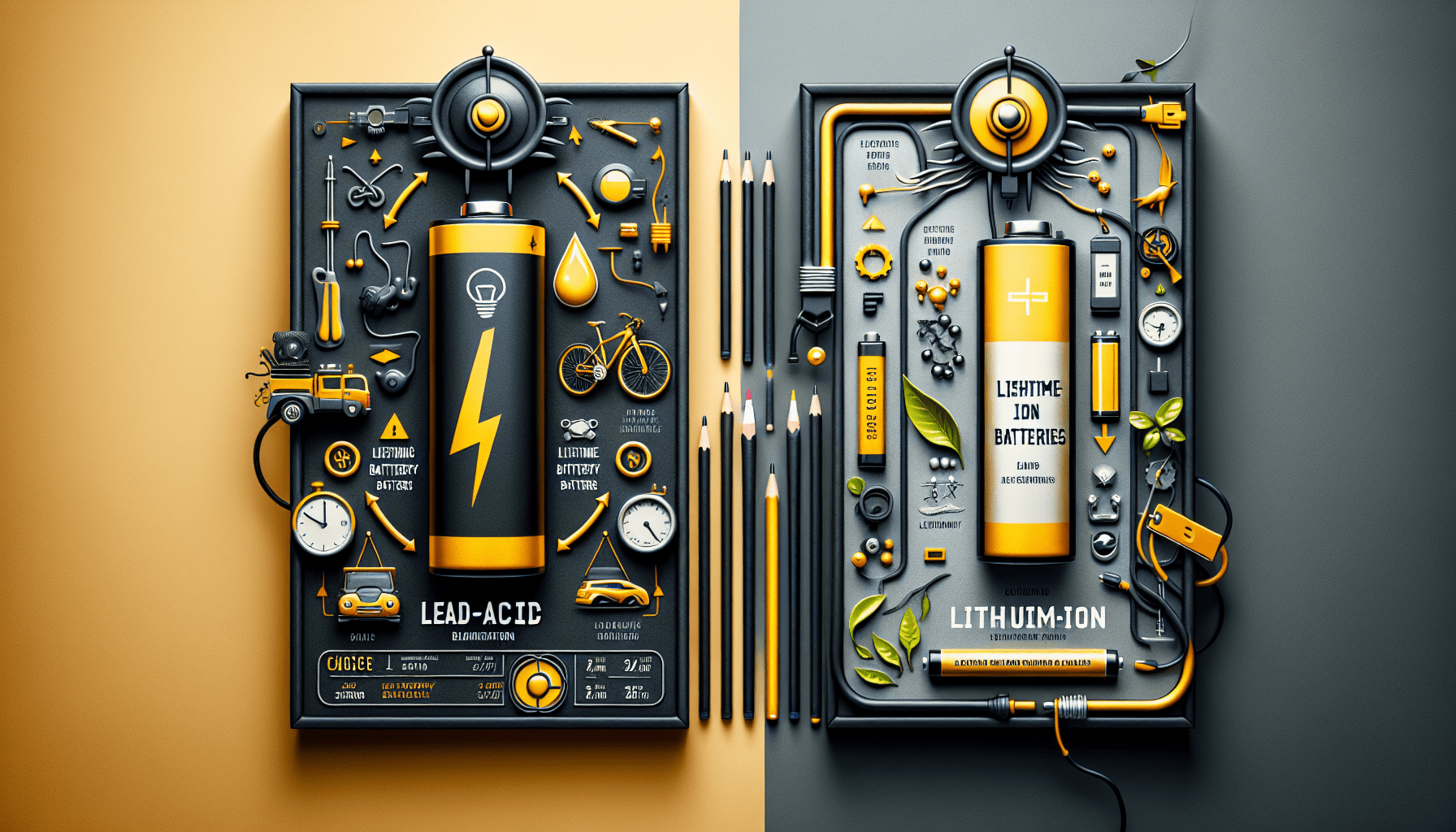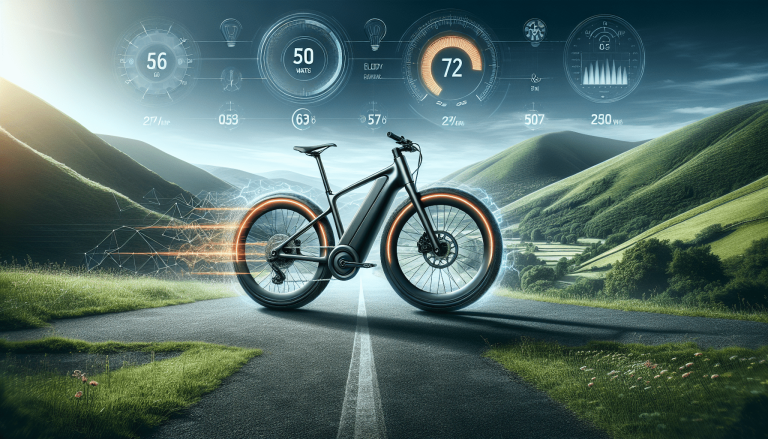Which Is Better Lead-acid Battery Or Lithium Ion Battery For Electric Bike?
Imagine riding through the city streets on an electric bike, wind in your hair, and a smile on your face. The only thing stopping you is the daunting decision between two battery options: lead-acid or lithium ion. But fear not, we’re here to help you make an informed choice. In this article, we’ll compare the pros and cons of lead-acid and lithium ion batteries for electric bikes, helping you determine which one is better suited for your two-wheeled adventures. So let’s saddle up and find out which battery reigns supreme!
Battery Types
Lead-acid Battery
lead-acid batteries have long been used in various applications, including electric bikes. These batteries are known for their reliability and affordability, which makes them a popular choice among electric bike manufacturers. One of the key advantages of lead-acid batteries is their ability to deliver high currents, allowing for better acceleration and performance. Additionally, lead-acid batteries are relatively simple to manufacture, which helps keep their cost low.
However, lead-acid batteries also have some drawbacks. They are quite heavy compared to other battery types, which can be a major concern for electric bike users looking for a lightweight vehicle. Lead-acid batteries also have limited energy density, meaning they may not provide as much range as other battery types. Charging time can also be longer compared to other batteries, requiring more time to fully charge the battery before hitting the road again.
Lithium Ion Battery
Lithium ion batteries have gained significant popularity and are widely used in various devices, including electric bikes. One of the main advantages of lithium ion batteries is their high energy density, allowing for greater range and longer-lasting rides. They are also considerably lighter than lead-acid batteries, making them ideal for electric bikes where weight plays a crucial role in performance and maneuverability.
In terms of charging time, lithium ion batteries are far superior to lead-acid batteries. They can be charged relatively quickly, allowing you to spend less time waiting and more time riding. Another advantage of lithium ion batteries is their high efficiency, which means they can deliver more power without wasting much energy. This translates into better performance and longer battery life.
However, lithium ion batteries do come with their own limitations. One of the main concerns is their higher cost compared to lead-acid batteries. The initial cost of a lithium ion battery can be significantly higher, which may deter some potential electric bike owners. Additionally, lithium ion batteries have a limited cycle life, meaning they will eventually degrade and lose capacity over time. There are also safety concerns associated with lithium ion batteries, such as the risk of thermal runaway, which can lead to fires or explosions if not properly managed.
Battery Performance
Capacity and Range
When it comes to electric bikes, battery capacity and range are important factors to consider. The capacity of a battery determines how much energy it can store, which directly affects the range of an electric bike. In general, lithium ion batteries have higher energy densities, allowing them to store more energy in a smaller size. This means that electric bikes equipped with lithium ion batteries are likely to have a greater range compared to those using lead-acid batteries.
Charging Time
Charging time is another critical aspect of battery performance. Electric bike users want to spend more time riding and less time waiting for their batteries to charge. In this regard, lithium ion batteries have a significant advantage. They can be charged much faster compared to lead-acid batteries, allowing you to recharge your electric bike in a shorter amount of time. This can be especially beneficial for commuters or people who rely heavily on their electric bikes for daily transportation.
Weight
The weight of the battery plays a crucial role in the overall performance and handling of an electric bike. Lead-acid batteries are known for their heaviness, which can make the bike feel sluggish and less maneuverable. On the other hand, lithium ion batteries are much lighter, contributing to a lighter overall bike weight. This results in improved acceleration, easier handling, and reduced strain on the bike’s components. Therefore, electric bikes equipped with lithium ion batteries tend to offer better performance and a more enjoyable riding experience.
Efficiency
Battery efficiency refers to how effectively the battery can convert stored energy into usable power. In this aspect, lithium ion batteries have the upper hand over lead-acid batteries. They have higher efficiency levels, meaning they can deliver more power with less energy wasted as heat. This increased efficiency translates into better performance and longer battery life for electric bikes. On the other hand, lead-acid batteries may have lower efficiency, resulting in reduced range and shorter battery life.
Cycle Life
Cycle life refers to the number of charge-discharge cycles a battery can endure before its capacity significantly decreases. Lithium ion batteries generally have a higher cycle life compared to lead-acid batteries. They can withstand more charge-discharge cycles without experiencing a significant decline in capacity. This means that if you opt for a lithium ion battery, you will likely enjoy a longer-lasting battery that maintains its performance over time.
Self-Discharge Rate
The self-discharge rate refers to the rate at which a battery loses its charge while not in use. While both lead-acid and lithium ion batteries will experience some level of self-discharge, the rate differs between the two. Lead-acid batteries tend to have a higher self-discharge rate, meaning they lose their charge more quickly when not in use. Lithium ion batteries, on the other hand, have a lower self-discharge rate, allowing you to store your electric bike for longer periods without worrying about the battery losing a significant amount of charge.

Environmental Impact
Toxicity
Battery toxicity is an important environmental factor to consider. Lead-acid batteries contain lead, a highly toxic metal that can cause harm to humans and the environment if not properly handled and disposed of. Proper recycling and disposal procedures are crucial to prevent lead contamination. In contrast, lithium ion batteries do not contain lead, making them less toxic and posing less risk to the environment. However, it is important to note that lithium ion batteries still contain other potentially harmful chemicals, so proper recycling and disposal practices are still necessary.
Recyclability
The recyclability of batteries is a significant factor in reducing their environmental impact. Lead-acid batteries are highly recyclable and have well-established recycling processes in place. The lead and other components of these batteries can be efficiently extracted and reused. On the other hand, lithium ion batteries can be more challenging to recycle due to their complex composition and the need for specialized facilities. However, efforts are being made to improve the recycling infrastructure for lithium ion batteries, as their use becomes more widespread.
Energy Efficiency
Energy efficiency is another aspect of environmental impact to consider. Lithium ion batteries are generally more energy-efficient compared to lead-acid batteries. This means that a higher percentage of the energy stored in a lithium ion battery can be converted into useful power, reducing energy waste and promoting sustainability. Electric bikes equipped with lithium ion batteries can thus contribute to more efficient and eco-friendly transportation options.
Cost
Initial Cost
The initial cost of a battery is an important consideration for electric bike buyers. Lead-acid batteries have a significant advantage in terms of cost. They are generally much cheaper compared to lithium ion batteries, making them a more affordable option for those on a tighter budget. If cost is a top priority for you, lead-acid batteries may be the more attractive choice.
Maintenance Cost
Another factor to consider is the maintenance cost associated with the different battery types. Lead-acid batteries typically require more maintenance compared to lithium ion batteries. They may require periodic checks, water refilling, and other maintenance activities. On the other hand, lithium ion batteries have lower maintenance requirements, reducing the overall maintenance cost over the lifetime of the electric bike.
Lifetime Cost
While lead-acid batteries may have a lower initial cost, the lifetime cost of the battery should also be taken into account. Lithium ion batteries tend to have a longer lifespan compared to lead-acid batteries. This means that, despite the higher initial cost, a lithium ion battery may offer better value in terms of cost per year of service. Additionally, the higher efficiency and performance of lithium ion batteries can result in lower overall operating costs, further contributing to their value over time.

Technology Advancements
Lead-acid Battery Advancements
Although lead-acid batteries have been around for a long time, advancements in technology have led to improvements in their performance and lifespan. Manufacturers have been working on enhancing the energy density of lead-acid batteries, allowing for greater range and improved performance. Additionally, developments in manufacturing processes have resulted in lighter and more compact lead-acid batteries, reducing the weight and size of electric bikes equipped with these batteries.
Lithium Ion Battery Advancements
Lithium ion batteries have also seen significant advancements over the years. Manufacturers have been improving the energy density of lithium ion batteries, allowing for even greater range and longer-lasting rides. They have also been working on enhancing the safety features of these batteries, addressing concerns such as the risk of thermal runaway. These advancements have made lithium ion batteries more reliable and safer for use in electric bikes.
Safety
Risk of Sulfuric Acid Leakage
One of the safety concerns associated with lead-acid batteries is the risk of sulfuric acid leakage. If the battery is damaged or cracked, it can leak sulfuric acid, which is highly corrosive and can cause harm to the user and the environment. Proper handling and maintenance procedures are essential to minimize this risk. It is important to regularly inspect lead-acid batteries and promptly address any signs of damage or leakage.
Risk of Thermal Runaway
Lithium ion batteries pose a potential risk of thermal runaway, which can lead to fires or explosions. Thermal runaway can occur if the battery is subjected to extreme temperatures or if it suffers mechanical damage. Proper handling, charging, and storage practices are crucial to prevent the risk of thermal runaway. It is important to follow manufacturer guidelines and take necessary precautions to ensure the safe use of lithium ion batteries.

Suitability for Electric Bikes
Weight
Weight is an important consideration when it comes to electric bikes. Lead-acid batteries tend to be much heavier compared to lithium ion batteries. This can significantly impact the weight of the electric bike, affecting its overall performance and handling. If a lightweight electric bike is desired, lithium ion batteries are generally the better choice.
Space
The compact size of lithium ion batteries makes them ideal for electric bikes, especially when space is limited. Lead-acid batteries are bulkier and may require more space for installation. If space is a concern, opting for a lithium ion battery can help ensure a more streamlined and space-efficient electric bike design.
Performance
When it comes to performance, lithium ion batteries have several advantages over lead-acid batteries. Their higher energy density and efficiency allow for greater acceleration, speed, and range. They also offer a more consistent and smooth power delivery, resulting in a more enjoyable riding experience. If top performance is a priority, lithium ion batteries are generally the preferred choice for electric bikes.
Market Trends
Preference of Electric Bike Manufacturers
In recent years, there has been a noticeable shift towards lithium ion batteries among electric bike manufacturers. Many manufacturers are choosing to equip their electric bike models with lithium ion batteries due to their superior performance, energy density, and efficiency. This trend is driven by the desire to offer consumers electric bikes with longer ranges, faster charging times, and overall better performance.
Consumer Demand
Consumer demand for electric bikes with lithium ion batteries is also on the rise. As electric bikes become more popular and mainstream, consumers are increasingly valuing the benefits that lithium ion batteries can provide. The desire for longer distances, shorter charging times, and enhanced performance has led to an increased demand for electric bikes equipped with lithium ion batteries. This demand is expected to continue growing as technology advancements further improve the capabilities and affordability of lithium ion batteries.

Conclusion
In conclusion, both lead-acid and lithium ion batteries have their pros and cons when it comes to electric bikes. Lead-acid batteries offer affordability, high current delivery, and reliability. However, they are heavier, have limited energy density, and longer charging times compared to lithium ion batteries. On the other hand, lithium ion batteries provide higher energy density, faster charging times, lighter weight, and better efficiency. However, they come at a higher initial cost and require proper handling and disposal due to safety and environmental concerns.
The choice between lead-acid and lithium ion batteries ultimately depends on individual preferences and priorities. If cost is the main concern, lead-acid batteries may be the more suitable option. However, if performance, range, and maintenance requirements are more important, lithium ion batteries are likely the better choice. The market trends and consumer demand suggest that lithium ion batteries are becoming the preferred battery type for electric bikes, thanks to their advancements in technology and overall superior performance. Ultimately, it is essential to consider all factors and make an informed decision based on personal needs and preferences when choosing the battery type for your electric bike.






